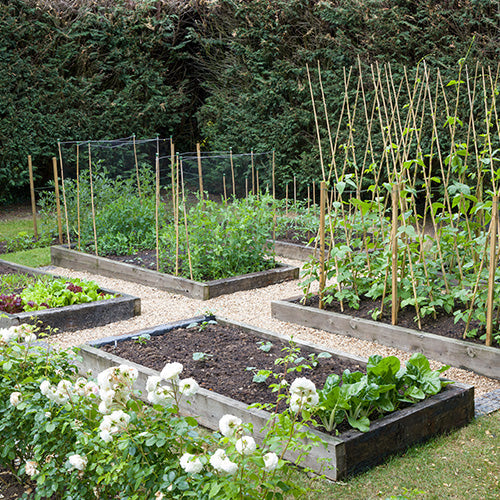You've finally been given the key to your allotment after what can be years of waiting - but where do you start?
A plot that hasn't been cultivated for a while can be disheartening - overrun with perennial weeds, rubbish and with no structure.
First, don't panic. This is a long-haul job and will take time. Take stock of your plot and make notes - any shady areas, remnants of former structures, areas contaminated by broken glass, etc. Clearing any rubbish you can’t use is a positive first task. You’ll also get to see what weeds you have to deal with and if there are any perennial crops, such as soft fruit or rhubarb.
Many growers believe that the best way to cultivate an allotment is by using raised beds with paths in between. If you would like to used raised beds on your allotment and the previous tenant hasn’t left theirs behind, step one is to create a plan of where your beds will go. Ensure you leave enough room for a wheelbarrow to get past comfortably - it's tempting to cram them in but they will be difficult to cultivate.
Design beds so you can comfortably reach from each side to the middle without overstretching. You can make your own beds or buy ready-made kits to suit your pocket and needs. If you have limited mobility, consider creating beds deeper than the usual 15cm-30cm (6"-12") so you don’t have to reach so far.
Once your plan’s drawn up, get to work marking out your paths. Some gardeners use rough mown grass but this can be slippy and needs upkeep. One cost-effective method is using a double layer of weed-resistant membrane over a freshly weeded area, covered with wood or bark chippings or sawdust. At the end of the season, this can be gathered up easily with a snow shovel and composted down.
Now for your raised beds. If you garden organically, the best way to get rid of perennial weeds such as dandelions, brambles and ground elder is by digging them up. If you start in autumn, cover the soil with thick cardboard (securely weighed down) to block out the light. In spring you’ll have a much easier job of clearing the ground. The cardboard will rot down to enrich the soil, too.
Everyone used to double dig beds (digging down to twice the depth of a spade) but no-dig gardening is gaining ground fast. It's often called 'lasagne layering' or 'sheet composting'. Start by covering the bed with brown cardboard or three sheets of newspaper, then wet it to start decomposition. After this, add anything you would to a compost heap but in alternate layers, keeping it watered.
'Brown' layer ingredients include fallen leaves, shredded newspaper, pine needles and small pieces of woody material, while the 'green' layer consists of vegetable scraps, garden trimmings and grass clippings. Brown layers need to be about twice as deep as green. The end result? Friable, fertile soil that you don't have to dig, full of beneficial micro-organisms.
It's really important not to skip these steps - they're the foundation of your allotment's success and you'll reap the rewards with bumper crops!














